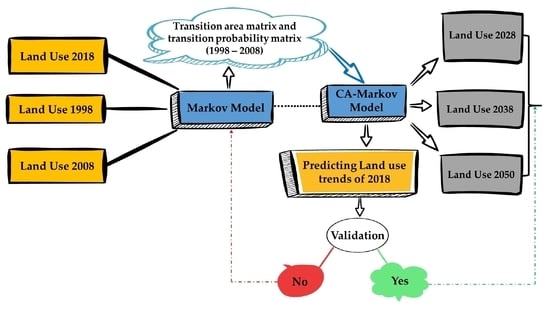Future Scenarios of Land Use/Land Cover (LULC) Based on a CA-Markov Simulation Model: Case of a Mediterranean Watershed in Morocco
Abstract
1. Introduction
2. Materials and Methods
2.1. Study Area
2.2. Satellite Images
2.3. LULC Modeling
2.3.1. Assessment Accuracy
- -
- User accuracyAu = Pii/Pi+
- -
- The precision of the producerAP = Pii/P+i
- -
- Overall accuracy
- -
- The kappa coefficient
2.3.2. Predictions of Future Scenarios Using CA-Markov
- -
- Selection of LULC maps from 1998, 2008 and 2018;
- -
- Application of the Markov transition estimator to the 1998 and 2008 maps to compute the transition probability matrix for the change from one LULC class to the other classes in 2018;
- -
- Using the 2008 map and transition probability data as the basis for simulating LULC in 2018;
- -
- The 2018 land use map is used as a reference, to evaluate the accuracy of the simulated LULC 2018 map (model validation);
- -
- Simulation of future LULC scenarios using the calibrated and validated CA-Markov model (Figure 2).
3. Results
3.1. Land Use Maps Reclassification
3.2. Markov Transition Estimator to Simulate 2018 Land Use and Validate CA-Markov Model
3.3. Markov Transition Estimator for the Projected 2028, 2038 and 2050 Years
4. Discussion
5. Conclusions
Author Contributions
Funding
Data Availability Statement
Acknowledgments
Conflicts of Interest
Appendix A

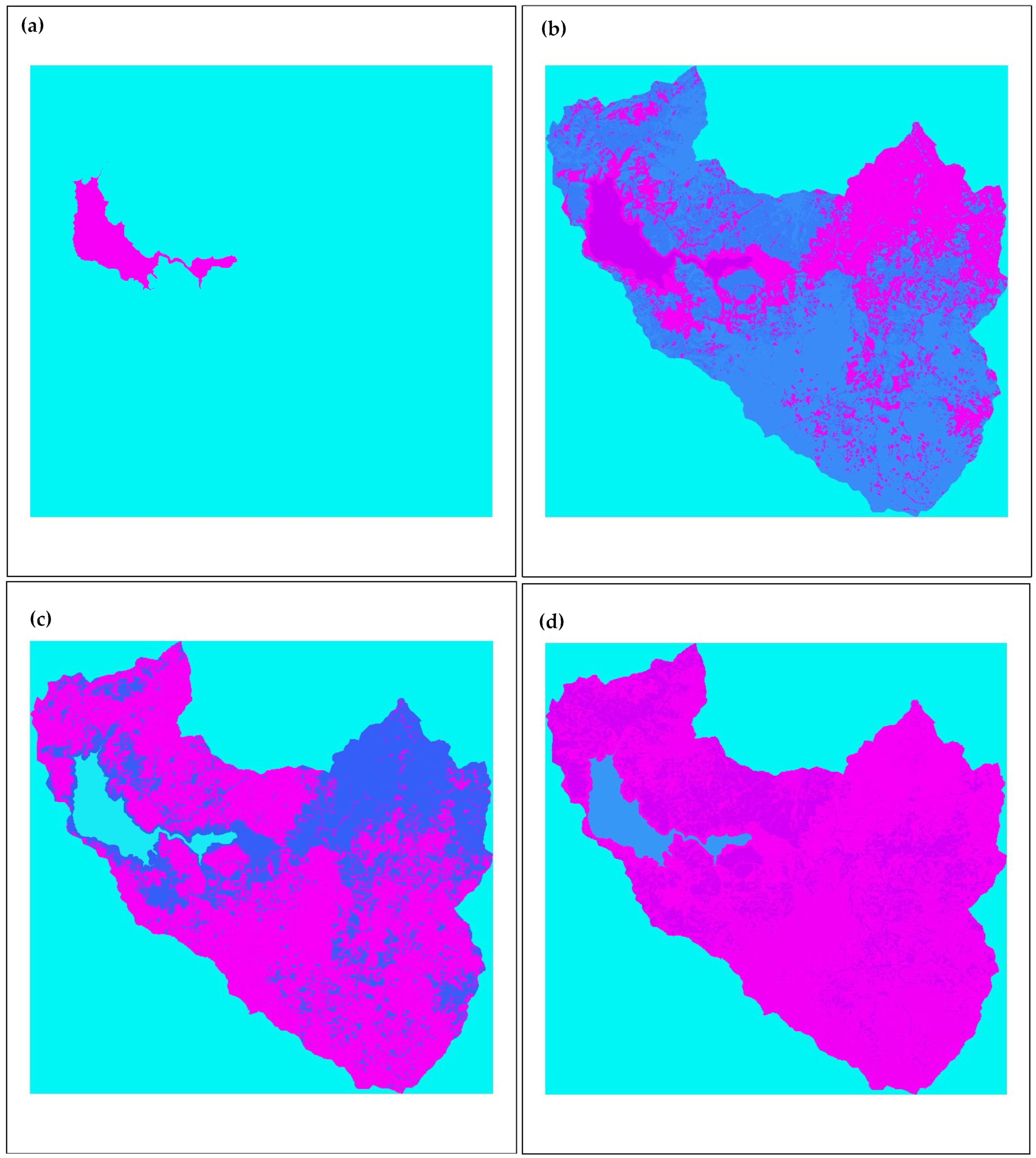
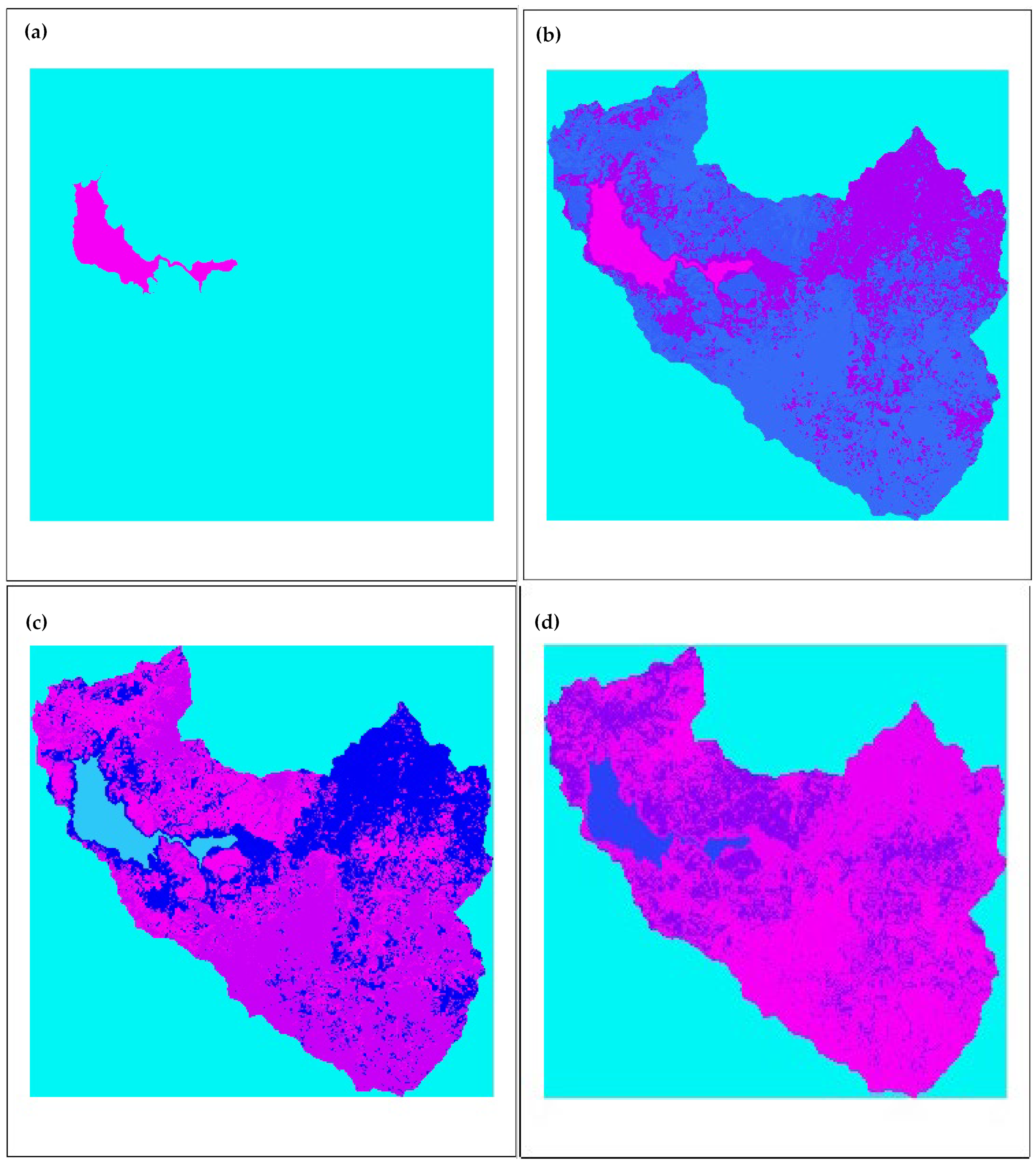
References
- Ramankutty, N.; Graumlich, L.; Achard, F.; Alves, D.; Chhabra, A.; DeFries, R.S.; Foley, J.A.; Geist, H.; Houghton, R.A.; Goldewijk, K.K.; et al. Global Land-Cover Change: Recent Progress, Remaining Challenges. In Land-Use and Land-Cover Change; Lambin, E.F., Geist, H., Eds.; Global Change—The IGBP Series; Springer Berlin Heidelberg: Berlin/Heidelberg, Germany, 2006; pp. 9–39. ISBN 978-3-540-32201-6. [Google Scholar]
- Rivas-Tabares, D.; Tarquis, A.M.; De Miguel, Á.; Gobin, A.; Willaarts, B. Enhancing LULC Scenarios Impact Assessment in Hydrological Dynamics Using Participatory Mapping Protocols in Semiarid Regions. Sci. Total Environ. 2022, 803, 149906. [Google Scholar] [CrossRef] [PubMed]
- Sun, Q.; Qi, W.; Yu, X. Impacts of Land Use Change on Ecosystem Services in the Intensive Agricultural Area of North China Based on Multi-Scenario Analysis. Alex. Eng. J. 2021, 60, 1703–1716. [Google Scholar] [CrossRef]
- Fu, Q.; Li, B.; Hou, Y.; Bi, X.; Zhang, X. Effects of Land Use and Climate Change on Ecosystem Services in Central Asia’s Arid Regions: A Case Study in Altay Prefecture, China. Sci. Total Environ. 2017, 607–608, 633–646. [Google Scholar] [CrossRef] [PubMed]
- Mingkuan, W.; Hongwei, M. The Impact of Spatial Heterogeneity on Ecosystem Service Value in a Case Study in Liuyang River Basin, China. J. Resour. Ecol. 2018, 9, 209–217. [Google Scholar] [CrossRef]
- Nourqolipour, R.; Mohamed Shariff, A.R.B.; Balasundram, S.K.; Ahmad, N.B.; Sood, A.M.; Buyong, T.; Amiri, F. A GIS-Based Model to Analyze the Spatial and Temporal Development of Oil Palm Land Use in Kuala Langat District, Malaysia. Enviorn. Earth Sci. 2015, 73, 1687–1700. [Google Scholar] [CrossRef]
- Liu, X.; Liang, X.; Li, X.; Xu, X.; Ou, J.; Chen, Y.; Li, S.; Wang, S.; Pei, F. A Future Land Use Simulation Model (FLUS) for Simulating Multiple Land Use Scenarios by Coupling Human and Natural Effects. Landsc. Urban Plan. 2017, 168, 94–116. [Google Scholar] [CrossRef]
- Hussain, S.; Lu, L.; Mubeen, M.; Nasim, W.; Karuppannan, S.; Fahad, S.; Tariq, A.; Mousa, B.G.; Mumtaz, F.; Aslam, M. Spatiotemporal Variation in Land Use Land Cover in the Response to Local Climate Change Using Multispectral Remote Sensing Data. Land 2022, 11, 595. [Google Scholar] [CrossRef]
- Revuelta-Acosta, J.D.; Guerrero-Luis, E.S.; Terrazas-Rodriguez, J.E.; Gomez-Rodriguez, C.; Alcalá Perea, G. Application of Remote Sensing Tools to Assess the Land Use and Land Cover Change in Coatzacoalcos, Veracruz, Mexico. Appl. Sci. 2022, 12, 1882. [Google Scholar] [CrossRef]
- Sundar, P.K.S.; Deka, P.C. Spatio-Temporal Classification and Prediction of Land Use and Land Cover Change for the Vembanad Lake System, Kerala—A Machine Learning Approach. Environ. Sci. Pollut. Res. 2021, 29, 86220–86236. [Google Scholar] [CrossRef]
- Abebe, G.; Getachew, D.; Ewunetu, A. Analysing Land Use/Land Cover Changes and Its Dynamics Using Remote Sensing and GIS in Gubalafito District, Northeastern Ethiopia. SN Appl. Sci. 2022, 4, 30. [Google Scholar] [CrossRef]
- Rehman, A.; Qin, J.; Shafi, S.; Khan, M.S.; Ullah, S.; Ahmad, K.; Rehman, N.U.; Faheem, M. Modelling of Land Use/Cover and LST Variations by Using GIS and Remote Sensing: A Case Study of the Northern Pakhtunkhwa Mountainous Region, Pakistan. Sensors 2022, 22, 4965. [Google Scholar] [CrossRef]
- Seyam, M.M.H.; Haque, M.R.; Rahman, M.M. Identifying the Land Use Land Cover (LULC) Changes Using Remote Sensing and GIS Approach: A Case Study at Bhaluka in Mymensingh, Bangladesh. Case Stud. Chem. Environ. Eng. 2023, 7, 100293. [Google Scholar] [CrossRef]
- Alshari, E.A.; Gawali, B.W. Development of Classification System for LULC Using Remote Sensing and GIS. Glob. Transit. Proc. 2021, 2, 8–17. [Google Scholar] [CrossRef]
- Ghosh, P.; Mukhopadhyay, A.; Chanda, A.; Mondal, P.; Akhand, A.; Mukherjee, S.; Nayak, S.K.; Ghosh, S.; Mitra, D.; Ghosh, T.; et al. Application of Cellular Automata and Markov-Chain Model in Geospatial Environmental Modeling—A Review. Remote Sens. Appl. Soc. Environ. 2017, 5, 64–77. [Google Scholar] [CrossRef]
- Jamali, A. Land Use Land Cover Modeling Using Optimized Machine Learning Classifiers: A Case Study of Shiraz, Iran. Model. Earth Syst. Environ. 2021, 7, 1539–1550. [Google Scholar] [CrossRef]
- Wang, M.; Wander, M.; Mueller, S.; Martin, N.; Dunn, J.B. Evaluation of Survey and Remote Sensing Data Products Used to Estimate Land Use Change in the United States: Evolving Issues and Emerging Opportunities. Environ. Sci. Policy 2022, 129, 68–78. [Google Scholar] [CrossRef]
- Aburas, M.M.; Ho, Y.M.; Ramli, M.F.; Ash’aari, Z.H. Improving the Capability of an Integrated CA-Markov Model to Simulate Spatio-Temporal Urban Growth Trends Using an Analytical Hierarchy Process and Frequency Ratio. Int. J. Appl. Earth Obs. Geoinf. 2017, 59, 65–78. [Google Scholar] [CrossRef]
- Gollnow, F.; Göpel, J.; de Barros Viana Hissa, L.; Schaldach, R.; Lakes, T. Scenarios of Land-Use Change in a Deforestation Corridor in the Brazilian Amazon: Combining Two Scales of Analysis. Reg. Environ. Chang. 2018, 18, 143–159. [Google Scholar] [CrossRef]
- Firozjaei, M.K.; Sedighi, A.; Argany, M.; Jelokhani-Niaraki, M.; Arsanjani, J.J. A Geographical Direction-Based Approach for Capturing the Local Variation of Urban Expansion in the Application of CA-Markov Model. Cities 2019, 93, 120–135. [Google Scholar] [CrossRef]
- Aburas, M.M.; Ahamad, M.S.S.; Omar, N.Q. Spatio-Temporal Simulation and Prediction of Land-Use Change Using Conventional and Machine Learning Models: A Review. Environ. Monit. Assess. 2019, 191, 205. [Google Scholar] [CrossRef]
- Briassoulis, H. Analysis of Land Use Change: Theoretical and Modeling Approaches, 2nd ed.; Loveridge, S., Jackson, R., Eds.; WVU Research Repository; University of the Aegean: Lesvos, Greece, 2020; p. 248. [Google Scholar]
- Yang, Y.; Bao, W.; Liu, Y. Scenario Simulation of Land System Change in the Beijing-Tianjin-Hebei Region. Land Use Policy 2020, 96, 104677. [Google Scholar] [CrossRef]
- Tsompanas, M.-A.; Fyrigos, I.-A.; Ntinas, V.; Adamatzky, A.; Sirakoulis, G.C. Cellular Automata Implementation of Oregonator Simulating Light-Sensitive Belousov–Zhabotinsky Medium. Nonlinear Dyn. 2021, 104, 4103–4115. [Google Scholar] [CrossRef]
- Santé, I.; García, A.M.; Miranda, D.; Crecente, R. Cellular Automata Models for the Simulation of Real-World Urban Processes: A Review and Analysis. Landsc. Urban Plan. 2010, 96, 108–122. [Google Scholar] [CrossRef]
- Falah, N.; Karimi, A.; Harandi, A.T. Urban Growth Modeling Using Cellular Automata Model and AHP (Case Study: Qazvin City). Model. Earth Syst. Environ. 2020, 6, 235–248. [Google Scholar] [CrossRef]
- Jokar Arsanjani, J.; Helbich, M.; Kainz, W.; Darvishi Boloorani, A. Integration of Logistic Regression, Markov Chain and Cellular Automata Models to Simulate Urban Expansion. Int. J. Appl. Earth Obs. Geoinf. 2013, 21, 265–275. [Google Scholar] [CrossRef]
- Mohammady, S.; Delavar, M.R.; Pahlavani, P. URBAN GROWTH MODELING USING AN ARTIFICIAL NEURAL NETWORK A CASE STUDY OF SANANDAJ CITY, IRAN. Int. Arch. Photogramm. Remote Sens. Spat. Inf. Sci. 2014, XL-2/W3, 203–208. [Google Scholar] [CrossRef]
- Karimi, H.; Jafarnezhad, J.; Khaledi, J.; Ahmadi, P. Monitoring and Prediction of Land Use/Land Cover Changes Using CA-Markov Model: A Case Study of Ravansar County in Iran. Arab. J. Geosci. 2018, 11, 592. [Google Scholar] [CrossRef]
- Gharaibeh, A.; Shaamala, A.; Obeidat, R.; Al-Kofahi, S. Improving Land-Use Change Modeling by Integrating ANN with Cellular Automata-Markov Chain Model. Heliyon 2020, 6, e05092. [Google Scholar] [CrossRef]
- Guan, D.; Li, H.; Inohae, T.; Su, W.; Nagaie, T.; Hokao, K. Modeling Urban Land Use Change by the Integration of Cellular Automaton and Markov Model. Ecol. Model. 2011, 222, 3761–3772. [Google Scholar] [CrossRef]
- Nouri, J.; Gharagozlou, A.; Arjmandi, R.; Faryadi, S.; Adl, M. Predicting Urban Land Use Changes Using a CA–Markov Model. Arab. J. Sci. Eng. 2014, 39, 5565–5573. [Google Scholar] [CrossRef]
- Kafy, A.-A.; Dey, N.N.; Al Rakib, A.; Rahaman, Z.A.; Nasher, N.M.R.; Bhatt, A. Modeling the Relationship between Land Use/Land Cover and Land Surface Temperature in Dhaka, Bangladesh Using CA-ANN Algorithm. Environ. Chall. 2021, 4, 100190. [Google Scholar] [CrossRef]
- Briak, H.; Moussadek, R.; Aboumaria, K.; Mrabet, R. Assessing Sediment Yield in Kalaya Gauged Watershed (Northern Morocco) Using GIS and SWAT Model. Int. Soil Water Conserv. Res. 2016, 4, 177–185. [Google Scholar] [CrossRef]
- Beroho, M.; Briak, H.; El Halimi, R.; Ouallali, A.; Boulahfa, I.; Mrabet, R.; Kebede, F.; Aboumaria, K. Analysis and Prediction of Climate Forecasts in Northern Morocco: Application of Multilevel Linear Mixed Effects Models Using R Software. Heliyon 2020, 6, e05094. [Google Scholar] [CrossRef]
- Briak, H.; Mrabet, R.; Moussadek, R.; Aboumaria, K. Use of a Calibrated SWAT Model to Evaluate the Effects of Agricultural BMPs on Sediments of the Kalaya River Basin (North of Morocco). Int. Soil Water Conserv. Res. 2019, 7, 176–183. [Google Scholar] [CrossRef]
- Ouallali, A.; Briak, H.; Aassoumi, H.; Beroho, M.; Bouhsane, N.; Moukhchane, M. Hydrological Foretelling Uncertainty Evaluation of Water Balance Components and Sediments Yield Using a Multi-Variable Optimization Approach in an External Rif’s Catchment. Morocco. Alex. Eng. J. 2020, 59, 775–789. [Google Scholar] [CrossRef]
- Inypsa Soil Survey at 1/100,000 (Edition at 1/50,000). Integrated Agricultural Development Project of Tangier-Tetouan, Tetouan Sector. Inypsa -Morocco, SA. and Provin. Direct. Agri. Tetouan, Map, 1p. 1987. Available online: https://horizon.documentation.ird.fr/exl-doc/pleins_textes/divers12-11/010052362.pdf (accessed on 13 February 2023).
- Li, X.; Feng, R.; Guan, X.; Shen, H.; Zhang, L. Remote Sensing Image Mosaicking: Achievements and Challenges. IEEE Geosci. Remote Sens. Mag. 2019, 7, 8–22. [Google Scholar] [CrossRef]
- Zhou, T.; Geng, Y.; Ji, C.; Xu, X.; Wang, H.; Pan, J.; Bumberger, J.; Haase, D.; Lausch, A. Prediction of Soil Organic Carbon and the C:N Ratio on a National Scale Using Machine Learning and Satellite Data: A Comparison between Sentinel-2, Sentinel-3 and Landsat-8 Images. Sci. Total Environ. 2021, 755, 142661. [Google Scholar] [CrossRef]
- Ahmed, K.R.; Akter, S. Analysis of Landcover Change in Southwest Bengal Delta Due to Floods by NDVI, NDWI and K-Means Cluster with Landsat Multi-Spectral Surface Reflectance Satellite Data. Remote Sens. Appl. Soc. Environ. 2017, 8, 168–181. [Google Scholar] [CrossRef]
- Mueller-Warrant, G. Multistep Block Mapping on Principal Component Uniformity Repairs Landsat 7 Defects. Int. J. Appl. Earth Obs. Geoinf. 2019, 79, 12–23. [Google Scholar] [CrossRef]
- Cooper, S.; Okujeni, A.; Pflugmacher, D.; van der Linden, S.; Hostert, P. Combining Simulated Hyperspectral EnMAP and Landsat Time Series for Forest Aboveground Biomass Mapping. Int. J. Appl. Earth Obs. Geoinf. 2021, 98, 102307. [Google Scholar] [CrossRef]
- Oliphant, A.J.; Thenkabail, P.S.; Teluguntla, P.; Xiong, J.; Gumma, M.K.; Congalton, R.G.; Yadav, K. Mapping Cropland Extent of Southeast and Northeast Asia Using Multi-Year Time-Series Landsat 30-m Data Using a Random Forest Classifier on the Google Earth Engine Cloud. Int. J. Appl. Earth Obs. Geoinf. 2019, 81, 110–124. [Google Scholar] [CrossRef]
- Da Cunha, E.R.; Santos, C.A.G.; da Silva, R.M.; Bacani, V.M.; Pott, A. Future Scenarios Based on a CA-Markov Land Use and Land Cover Simulation Model for a Tropical Humid Basin in the Cerrado/Atlantic Forest Ecotone of Brazil. Land Use Policy 2021, 101, 105141. [Google Scholar] [CrossRef]
- Aburas, M.M.; Ho, Y.M.; Ramli, M.F.; Ash’aari, Z.H. The Simulation and Prediction of Spatio-Temporal Urban Growth Trends Using Cellular Automata Models: A Review. Int. J. Appl. Earth Obs. Geoinf. 2016, 52, 380–389. [Google Scholar] [CrossRef]
- Eastman, J.R. IDRISI Selva; Clark University: Worcester, MA, USA, 2012; Available online: http://uhulag.mendelu.cz/files/pagesdata/eng/gis/idrisi_selva_tutorial.pdf (accessed on 13 February 2023).
- Kura, A.L.; Beyene, D.L. Cellular Automata Markov Chain Model Based Deforestation Modelling in the Pastoral and Agro-Pastoral Areas of Southern Ethiopia. Remote Sens. Appl. Soc. Environ. 2020, 18, 100321. [Google Scholar] [CrossRef]
- De Oliveira Barros, K.; Alvares Soares Ribeiro, C.A.; Marcatti, G.E.; Lorenzon, A.S.; Martins de Castro, N.L.; Domingues, G.F.; Romário de Carvalho, J.; Rosa dos Santos, A. Markov Chains and Cellular Automata to Predict Environments Subject to Desertification. J. Environ. Manag. 2018, 225, 160–167. [Google Scholar] [CrossRef]
- Varga, O.G.; Pontius, R.G.; Singh, S.K.; Szabó, S. Intensity Analysis and the Figure of Merit’s Components for Assessment of a Cellular Automata—Markov Simulation Model. Ecol. Indic. 2019, 101, 933–942. [Google Scholar] [CrossRef]
- Sfa, F.E.; Nemiche, M.; Rayd, H. A Generic Macroscopic Cellular Automata Model for Land Use Change: The Case of the Drâa Valley. Ecol. Complex. 2020, 43, 100851. [Google Scholar] [CrossRef]
- Vernon, M.J.; Sherriff, R.L.; van Mantgem, P.; Kane, J.M. Thinning, Tree-Growth, and Resistance to Multi-Year Drought in a Mixed-Conifer Forest of Northern California. For. Ecol. Manag. 2018, 422, 190–198. [Google Scholar] [CrossRef]
- Jazouli, A.E.; Barakat, A.; Khellouk, R.; Rais, J.; Baghdadi, M.E. Remote Sensing and GIS Techniques for Prediction of Land Use Land Cover Change Effects on Soil Erosion in the High Basin of the Oum Er Rbia River (Morocco). Remote Sens. Appl. Soc. Environ. 2019, 13, 361–374. [Google Scholar] [CrossRef]
- Landis, J.R.; Koch, G.G. The Measurement of Observer Agreement for Categorical Data. Biometrics 1977, 33, 159. [Google Scholar] [CrossRef]
- Kusi, K.K.; Khattabi, A.; Mhammdi, N.; Lahssini, S. Prospective Evaluation of the Impact of Land Use Change on Ecosystem Services in the Ourika Watershed, Morocco. Land Use Policy 2020, 97, 104796. [Google Scholar] [CrossRef]
- Serasinghe Pathiranage, I.S.; Kantakumar, L.N.; Sundaramoorthy, S. Remote Sensing Data and SLEUTH Urban Growth Model: As Decision Support Tools for Urban Planning. Chin. Geogr. Sci. 2018, 28, 274–286. [Google Scholar] [CrossRef]
- Huang, S.; Tang, L.; Hupy, J.P.; Wang, Y.; Shao, G. A Commentary Review on the Use of Normalized Difference Vegetation Index (NDVI) in the Era of Popular Remote Sensing. J. For. Res. 2021, 32, 1–6. [Google Scholar] [CrossRef]
- Saxena, A.; Jat, M.K.; Clarke, K.C. Development of SLEUTH-Density for the Simulation of Built-up Land Density. Comput. Environ. Urban Syst. 2021, 86, 101586. [Google Scholar] [CrossRef]
- Saadani, S.; Laajaj, R.; Maanan, M.; Rhinane, H.; Aaroud, A. Simulating Spatial–Temporal Urban Growth of a Moroccan Metropolitan Using CA–Markov Model. Spat. Inf. Res. 2020, 28, 609–621. [Google Scholar] [CrossRef]
- Palmate, S.S.; Pandey, A.; Mishra, S.K. Modelling Spatiotemporal Land Dynamics for a Trans-Boundary River Basin Using Integrated Cellular Automata and Markov Chain Approach. Appl. Geogr. 2017, 82, 11–23. [Google Scholar] [CrossRef]
- White, R.; Engelen, G.; Uljee, I. The Use of Constrained Cellular Automata for High-Resolution Modelling of Urban Land-Use Dynamics. Environ. Plann. B 1997, 24, 323–343. [Google Scholar] [CrossRef]
- Mwaniki, M.W.; Agutu, N.O.; Mbaka, J.G.; Ngigi, T.G.; Waithaka, E.H. Landslide Scar/Soil Erodibility Mapping Using Landsat TM/ETM+ Bands 7 and 3 Normalised Difference Index: A Case Study of Central Region of Kenya. Appl. Geogr. 2015, 64, 108–120. [Google Scholar] [CrossRef]
- Hirich, A.; Fatnassi, H.; Ragab, R.; Choukr-Allah, R. Prediction of Climate Change Impact on Corn Grown in the South of Morocco Using the Saltmed Model: Prediction of Climate Change Impact on Corn. Irrig. Drain. 2016, 65, 9–18. [Google Scholar] [CrossRef]
- Ouhamdouch, S.; Bahir, M. Climate Change Impact on Future Rainfall and Temperature in Semi-Arid Areas (Essaouira Basin, Morocco). Environ. Process. 2017, 4, 975–990. [Google Scholar] [CrossRef]
- Brouziyne, Y.; Abouabdillah, A.; Hirich, A.; Bouabid, R.; Zaaboul, R.; Benaabidate, L. Modeling Sustainable Adaptation Strategies toward a Climate-Smart Agriculture in a Mediterranean Watershed under Projected Climate Change Scenarios. Agric. Syst. 2018, 162, 154–163. [Google Scholar] [CrossRef]

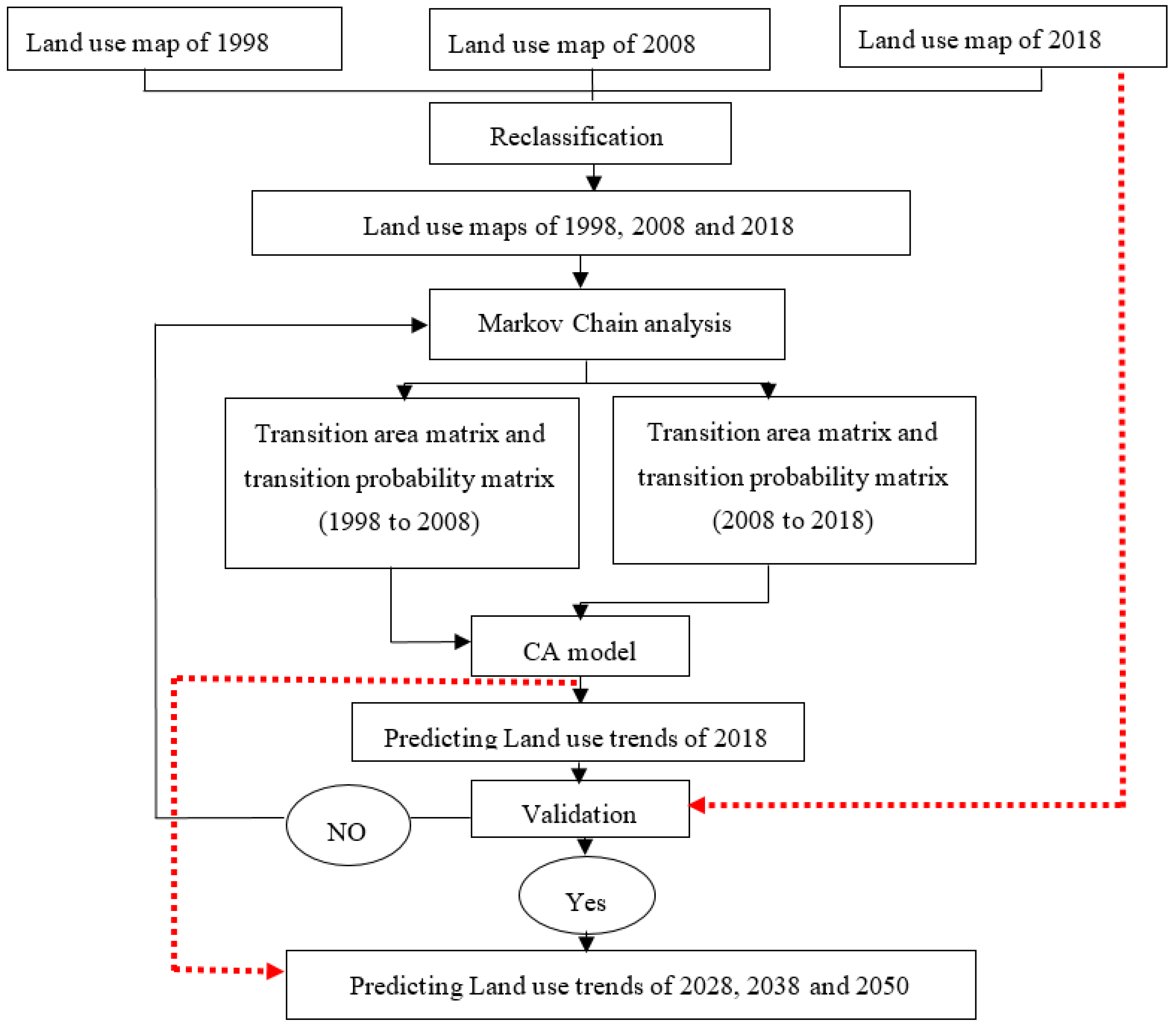
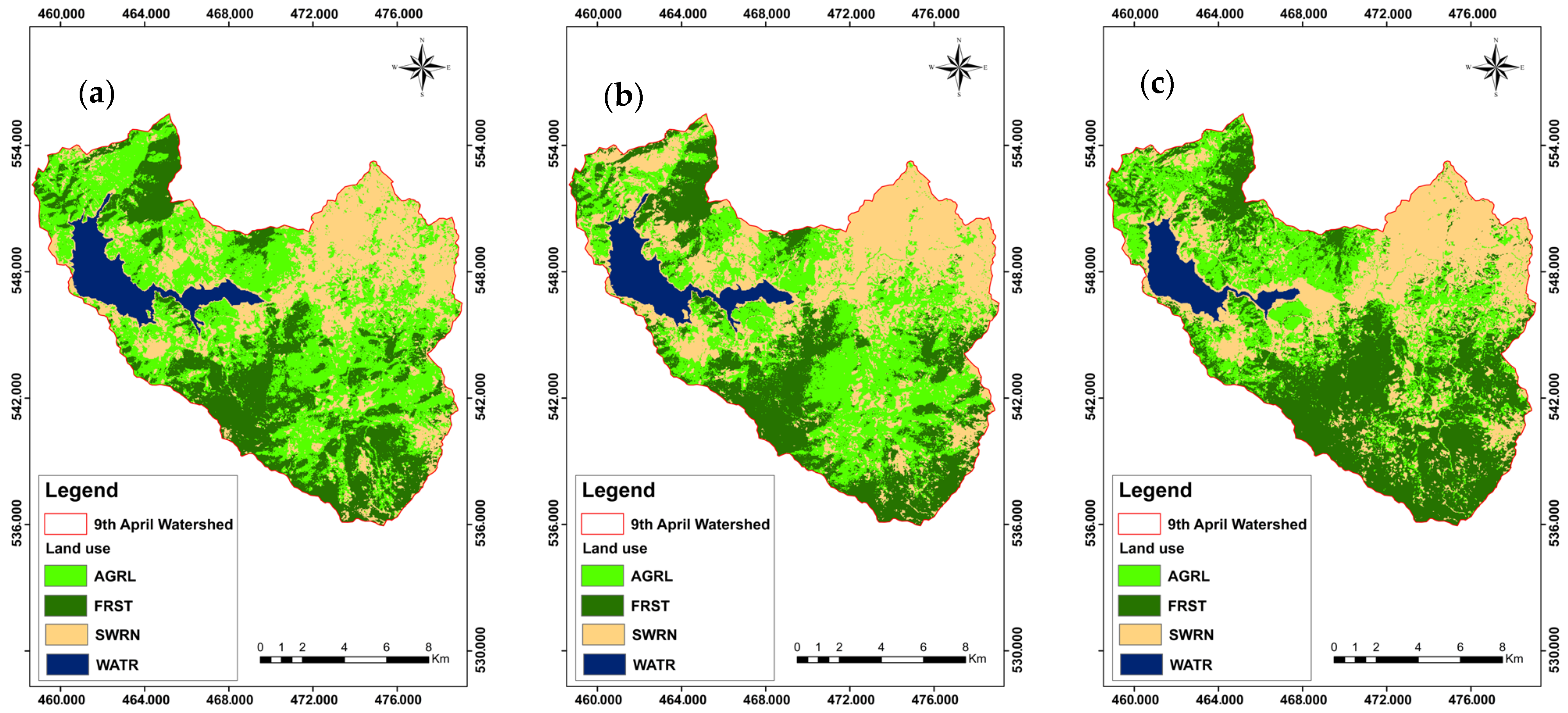
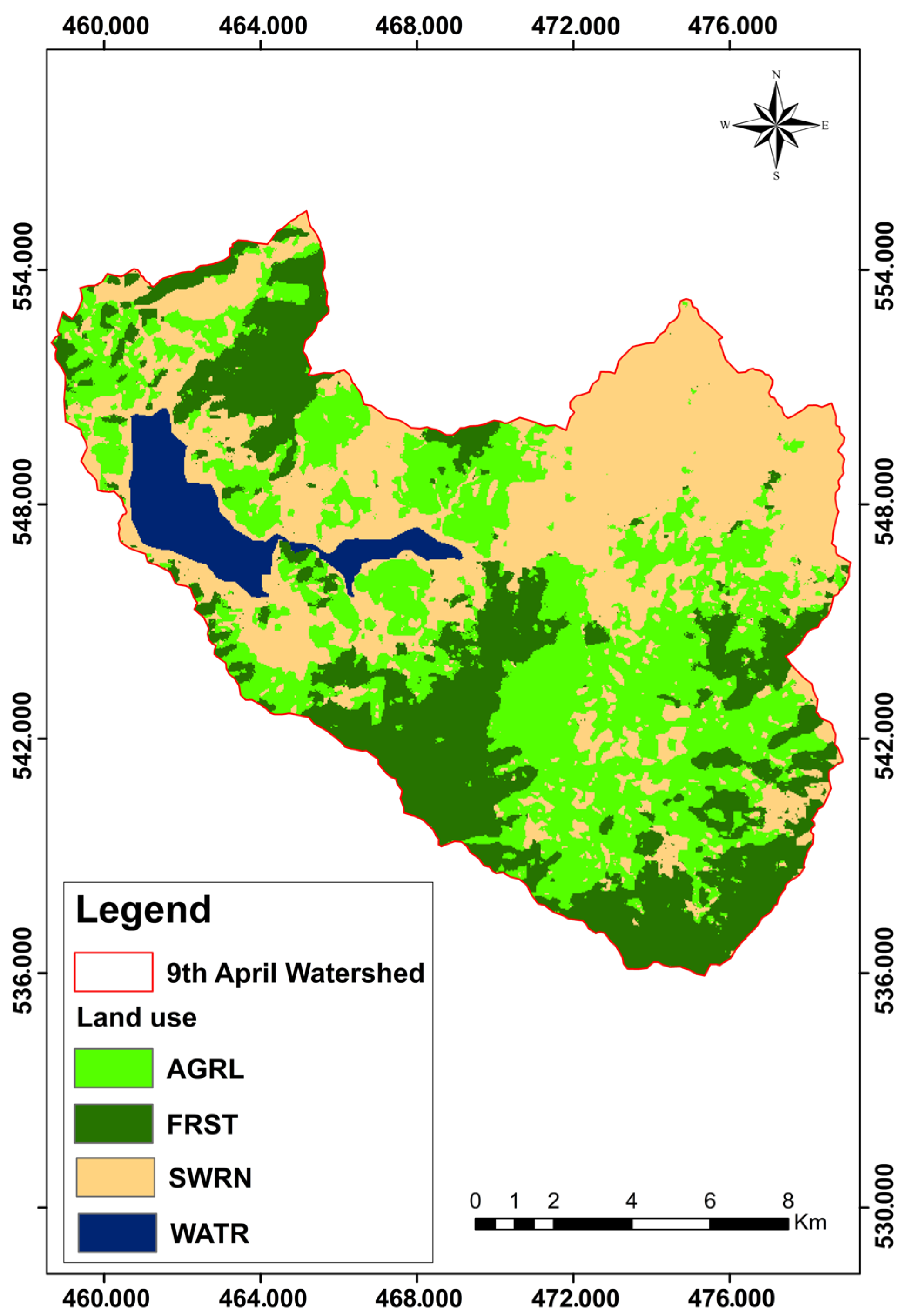


| WATR | SWRN | FRST | AGRL | |
|---|---|---|---|---|
| WATR | 0.8086 | 0.1914 | 0.0000 | 0.0000 |
| SWRN | 0.0005 | 0.7293 | 0.0975 | 0.1727 |
| FRST | 0.0000 | 0.0337 | 0.6322 | 0.3341 |
| AGRL | 0.0000 | 0.2943 | 0.1737 | 0.5320 |
| WATR | SWRN | FRST | AGRL | |
|---|---|---|---|---|
| WATR | 0.6341 | 0.3659 | 0.0000 | 0.0000 |
| SWRN | 0.0000 | 0.6506 | 0.0703 | 0.2791 |
| FRST | 0.0000 | 0.0686 | 0.6747 | 0.2567 |
| AGRL | 0.0000 | 0.0951 | 0.4954 | 0.4095 |
| WATR | SWRN | FRST | AGRL | |
|---|---|---|---|---|
| WATR | 0.4731 | 0.4561 | 0.0142 | 0.0566 |
| SWRN | 0.0000 | 0.5130 | 0.1905 | 0.2965 |
| FRST | 0.0000 | 0.1103 | 0.5974 | 0.2923 |
| AGRL | 0.0000 | 0.1316 | 0.5977 | 0.2707 |
| WATR | SWRN | FRST | AGRL | |
|---|---|---|---|---|
| WATR | 0.3290 | 0.4955 | 0.0584 | 0.1170 |
| SWRN | 0.0000 | 0.3960 | 0.3134 | 0.2906 |
| FRST | 0.0000 | 0.1488 | 0.5493 | 0.3019 |
| AGRL | 0.0000 | 0.1571 | 0.6237 | 0.2192 |
| Areas in Km2 | ||||
|---|---|---|---|---|
| Years | WATR | SWRN | FRST | AGRL |
| 2028 | 6.04 | 59.55 | 90.45 | 64.70 |
| 2038 | 4.50 | 56.83 | 98.33 | 61.09 |
| 2050 | 3.15 | 53.83 | 104.64 | 59.15 |
Disclaimer/Publisher’s Note: The statements, opinions and data contained in all publications are solely those of the individual author(s) and contributor(s) and not of MDPI and/or the editor(s). MDPI and/or the editor(s) disclaim responsibility for any injury to people or property resulting from any ideas, methods, instructions or products referred to in the content. |
© 2023 by the authors. Licensee MDPI, Basel, Switzerland. This article is an open access article distributed under the terms and conditions of the Creative Commons Attribution (CC BY) license (https://creativecommons.org/licenses/by/4.0/).
Share and Cite
Beroho, M.; Briak, H.; Cherif, E.K.; Boulahfa, I.; Ouallali, A.; Mrabet, R.; Kebede, F.; Bernardino, A.; Aboumaria, K. Future Scenarios of Land Use/Land Cover (LULC) Based on a CA-Markov Simulation Model: Case of a Mediterranean Watershed in Morocco. Remote Sens. 2023, 15, 1162. https://doi.org/10.3390/rs15041162
Beroho M, Briak H, Cherif EK, Boulahfa I, Ouallali A, Mrabet R, Kebede F, Bernardino A, Aboumaria K. Future Scenarios of Land Use/Land Cover (LULC) Based on a CA-Markov Simulation Model: Case of a Mediterranean Watershed in Morocco. Remote Sensing. 2023; 15(4):1162. https://doi.org/10.3390/rs15041162
Chicago/Turabian StyleBeroho, Mohamed, Hamza Briak, El Khalil Cherif, Imane Boulahfa, Abdessalam Ouallali, Rachid Mrabet, Fassil Kebede, Alexandre Bernardino, and Khadija Aboumaria. 2023. "Future Scenarios of Land Use/Land Cover (LULC) Based on a CA-Markov Simulation Model: Case of a Mediterranean Watershed in Morocco" Remote Sensing 15, no. 4: 1162. https://doi.org/10.3390/rs15041162
APA StyleBeroho, M., Briak, H., Cherif, E. K., Boulahfa, I., Ouallali, A., Mrabet, R., Kebede, F., Bernardino, A., & Aboumaria, K. (2023). Future Scenarios of Land Use/Land Cover (LULC) Based on a CA-Markov Simulation Model: Case of a Mediterranean Watershed in Morocco. Remote Sensing, 15(4), 1162. https://doi.org/10.3390/rs15041162








